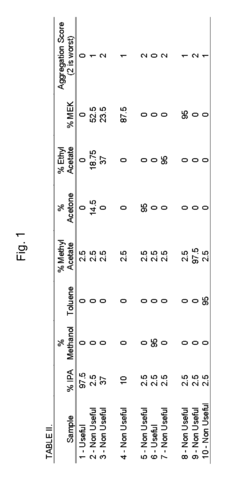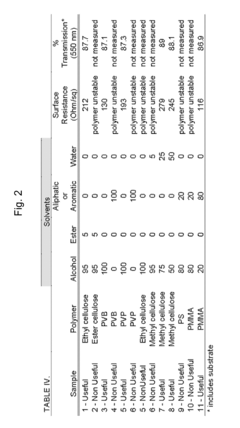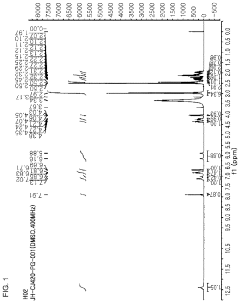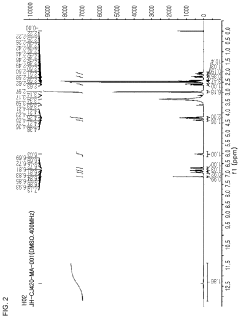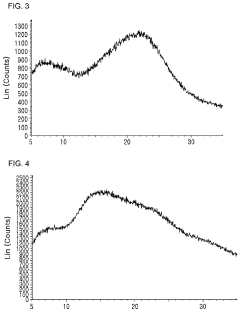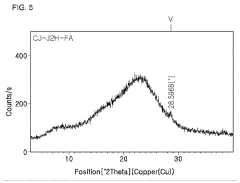Ethyl Acetate as a Solvent: Benefits and Limitations
JUN 27, 20259 MIN READ
Generate Your Research Report Instantly with AI Agent
Patsnap Eureka helps you evaluate technical feasibility & market potential.
Ethyl Acetate Overview
Ethyl acetate, a colorless liquid with a characteristic sweet odor, is a versatile organic compound widely used as a solvent in various industries. This ester, with the chemical formula CH3COOC2H5, is produced through the esterification of ethanol and acetic acid. Its molecular structure consists of an ethyl group connected to an acetate group, resulting in unique properties that make it valuable in numerous applications.
The physical properties of ethyl acetate contribute significantly to its effectiveness as a solvent. With a boiling point of 77.1°C and a melting point of -83.6°C, it remains liquid at room temperature, facilitating its use in various processes. Its low viscosity and moderate polarity allow it to dissolve a wide range of organic compounds, making it an excellent choice for many industrial and laboratory applications.
In the chemical industry, ethyl acetate serves as a crucial solvent for the production of paints, coatings, and adhesives. Its ability to dissolve cellulose nitrate and many resins makes it indispensable in the formulation of lacquers and varnishes. The rapid evaporation rate of ethyl acetate contributes to its popularity in these applications, as it allows for quick drying and efficient processing.
The pharmaceutical sector also relies heavily on ethyl acetate. It is employed in the extraction and purification of various drugs and active pharmaceutical ingredients. Its relatively low toxicity compared to other organic solvents makes it a preferred choice in many pharmaceutical processes, where product purity and safety are paramount.
In the food industry, ethyl acetate finds application as a flavoring agent and in the decaffeination of coffee and tea. Its natural occurrence in many fruits and wines contributes to its acceptance as a food additive. However, its use in this sector is carefully regulated to ensure consumer safety.
The electronics industry utilizes ethyl acetate in the production of circuit boards and semiconductor devices. Its ability to dissolve certain polymers and its low conductivity make it suitable for cleaning and degreasing electronic components without causing damage.
Despite its numerous benefits, ethyl acetate also presents certain limitations. Its flammability and volatility require careful handling and storage to prevent fire hazards. Additionally, prolonged exposure to high concentrations of ethyl acetate vapors can cause respiratory irritation and other health issues, necessitating proper ventilation and personal protective equipment in industrial settings.
Environmental concerns also factor into the use of ethyl acetate. While it is less harmful than many other organic solvents, its release into the environment can still contribute to air pollution and the formation of ground-level ozone. As a result, industries are increasingly focusing on recycling and proper disposal methods to mitigate its environmental impact.
The physical properties of ethyl acetate contribute significantly to its effectiveness as a solvent. With a boiling point of 77.1°C and a melting point of -83.6°C, it remains liquid at room temperature, facilitating its use in various processes. Its low viscosity and moderate polarity allow it to dissolve a wide range of organic compounds, making it an excellent choice for many industrial and laboratory applications.
In the chemical industry, ethyl acetate serves as a crucial solvent for the production of paints, coatings, and adhesives. Its ability to dissolve cellulose nitrate and many resins makes it indispensable in the formulation of lacquers and varnishes. The rapid evaporation rate of ethyl acetate contributes to its popularity in these applications, as it allows for quick drying and efficient processing.
The pharmaceutical sector also relies heavily on ethyl acetate. It is employed in the extraction and purification of various drugs and active pharmaceutical ingredients. Its relatively low toxicity compared to other organic solvents makes it a preferred choice in many pharmaceutical processes, where product purity and safety are paramount.
In the food industry, ethyl acetate finds application as a flavoring agent and in the decaffeination of coffee and tea. Its natural occurrence in many fruits and wines contributes to its acceptance as a food additive. However, its use in this sector is carefully regulated to ensure consumer safety.
The electronics industry utilizes ethyl acetate in the production of circuit boards and semiconductor devices. Its ability to dissolve certain polymers and its low conductivity make it suitable for cleaning and degreasing electronic components without causing damage.
Despite its numerous benefits, ethyl acetate also presents certain limitations. Its flammability and volatility require careful handling and storage to prevent fire hazards. Additionally, prolonged exposure to high concentrations of ethyl acetate vapors can cause respiratory irritation and other health issues, necessitating proper ventilation and personal protective equipment in industrial settings.
Environmental concerns also factor into the use of ethyl acetate. While it is less harmful than many other organic solvents, its release into the environment can still contribute to air pollution and the formation of ground-level ozone. As a result, industries are increasingly focusing on recycling and proper disposal methods to mitigate its environmental impact.
Market Analysis
The global market for ethyl acetate as a solvent has shown steady growth in recent years, driven by its versatile applications across various industries. The automotive, packaging, and electronics sectors have been key contributors to this growth, with increasing demand for paints, coatings, and adhesives. The pharmaceutical industry also relies heavily on ethyl acetate for drug formulation and extraction processes, further boosting market demand.
In terms of regional distribution, Asia-Pacific has emerged as the largest consumer of ethyl acetate, primarily due to rapid industrialization in countries like China and India. North America and Europe follow, with mature markets showing stable consumption patterns. The Middle East and Africa region is expected to witness significant growth in the coming years, driven by expanding industrial activities and infrastructure development.
The market dynamics of ethyl acetate are closely tied to the fluctuations in raw material prices, particularly ethanol and acetic acid. These price variations can significantly impact profit margins for manufacturers and influence market growth. Additionally, the increasing focus on sustainable and eco-friendly solvents poses both a challenge and an opportunity for the ethyl acetate market.
One of the key benefits driving the adoption of ethyl acetate is its relatively low toxicity compared to other organic solvents. This characteristic makes it a preferred choice in industries where worker safety and environmental regulations are stringent. However, the flammability of ethyl acetate remains a concern, necessitating proper handling and storage protocols.
The market is also influenced by the growing trend towards bio-based solvents. While traditional ethyl acetate is derived from petrochemical sources, there is an increasing interest in bio-ethyl acetate produced from renewable resources. This shift aligns with the global push for sustainability and could reshape the market landscape in the coming years.
Competition in the ethyl acetate market is intense, with several major chemical companies vying for market share. Product differentiation, pricing strategies, and supply chain optimization are crucial factors determining competitive advantage. The market also sees frequent collaborations and partnerships between manufacturers and end-users to develop tailored solutions for specific applications.
Looking ahead, the ethyl acetate market is projected to continue its growth trajectory, albeit with potential challenges. The development of alternative solvents and stricter environmental regulations may impact market dynamics. However, ongoing research into new applications and the continuous improvement of production processes are expected to open up new opportunities for market expansion.
In terms of regional distribution, Asia-Pacific has emerged as the largest consumer of ethyl acetate, primarily due to rapid industrialization in countries like China and India. North America and Europe follow, with mature markets showing stable consumption patterns. The Middle East and Africa region is expected to witness significant growth in the coming years, driven by expanding industrial activities and infrastructure development.
The market dynamics of ethyl acetate are closely tied to the fluctuations in raw material prices, particularly ethanol and acetic acid. These price variations can significantly impact profit margins for manufacturers and influence market growth. Additionally, the increasing focus on sustainable and eco-friendly solvents poses both a challenge and an opportunity for the ethyl acetate market.
One of the key benefits driving the adoption of ethyl acetate is its relatively low toxicity compared to other organic solvents. This characteristic makes it a preferred choice in industries where worker safety and environmental regulations are stringent. However, the flammability of ethyl acetate remains a concern, necessitating proper handling and storage protocols.
The market is also influenced by the growing trend towards bio-based solvents. While traditional ethyl acetate is derived from petrochemical sources, there is an increasing interest in bio-ethyl acetate produced from renewable resources. This shift aligns with the global push for sustainability and could reshape the market landscape in the coming years.
Competition in the ethyl acetate market is intense, with several major chemical companies vying for market share. Product differentiation, pricing strategies, and supply chain optimization are crucial factors determining competitive advantage. The market also sees frequent collaborations and partnerships between manufacturers and end-users to develop tailored solutions for specific applications.
Looking ahead, the ethyl acetate market is projected to continue its growth trajectory, albeit with potential challenges. The development of alternative solvents and stricter environmental regulations may impact market dynamics. However, ongoing research into new applications and the continuous improvement of production processes are expected to open up new opportunities for market expansion.
Technical Challenges
Despite its widespread use, ethyl acetate as a solvent faces several technical challenges that limit its applicability in certain scenarios. One of the primary concerns is its high volatility, which can lead to significant solvent loss during storage and use. This not only increases operational costs but also poses environmental and safety risks due to the release of volatile organic compounds (VOCs) into the atmosphere.
The flammability of ethyl acetate presents another major challenge, particularly in industrial settings. With a low flash point of approximately -4°C (25°F), it requires stringent safety measures and specialized handling procedures to prevent fire hazards. This necessitates additional investments in safety equipment and training, potentially increasing the overall cost of operations.
Ethyl acetate's limited solubility in water poses challenges in certain applications, particularly in aqueous-based processes or when water contamination is a concern. This characteristic can lead to phase separation issues and may require additional processing steps or the use of co-solvents to achieve desired results, thereby complicating process design and potentially increasing production costs.
The chemical reactivity of ethyl acetate, while beneficial in some applications, can be problematic in others. Its susceptibility to hydrolysis in the presence of water or acids can lead to the formation of ethanol and acetic acid, potentially altering the properties of the final product or interfering with other chemical processes. This reactivity necessitates careful consideration of storage conditions and process parameters to maintain solvent stability.
From an environmental perspective, the biodegradability of ethyl acetate, while generally considered an advantage, can present challenges in waste management and disposal. Rapid degradation may lead to the formation of byproducts that require additional treatment before release into the environment, potentially increasing the complexity and cost of waste handling processes.
The relatively low boiling point of ethyl acetate (77.1°C) can be a limitation in high-temperature applications or processes requiring prolonged heating. This characteristic may necessitate the use of pressure vessels or alternative solvents in certain scenarios, potentially limiting the versatility of ethyl acetate in some industrial processes.
Lastly, the potential for ethyl acetate to form azeotropes with water and other solvents can complicate purification and recycling processes. This behavior may require specialized separation techniques, such as azeotropic distillation, to achieve high purity levels, adding complexity and cost to solvent recovery operations.
The flammability of ethyl acetate presents another major challenge, particularly in industrial settings. With a low flash point of approximately -4°C (25°F), it requires stringent safety measures and specialized handling procedures to prevent fire hazards. This necessitates additional investments in safety equipment and training, potentially increasing the overall cost of operations.
Ethyl acetate's limited solubility in water poses challenges in certain applications, particularly in aqueous-based processes or when water contamination is a concern. This characteristic can lead to phase separation issues and may require additional processing steps or the use of co-solvents to achieve desired results, thereby complicating process design and potentially increasing production costs.
The chemical reactivity of ethyl acetate, while beneficial in some applications, can be problematic in others. Its susceptibility to hydrolysis in the presence of water or acids can lead to the formation of ethanol and acetic acid, potentially altering the properties of the final product or interfering with other chemical processes. This reactivity necessitates careful consideration of storage conditions and process parameters to maintain solvent stability.
From an environmental perspective, the biodegradability of ethyl acetate, while generally considered an advantage, can present challenges in waste management and disposal. Rapid degradation may lead to the formation of byproducts that require additional treatment before release into the environment, potentially increasing the complexity and cost of waste handling processes.
The relatively low boiling point of ethyl acetate (77.1°C) can be a limitation in high-temperature applications or processes requiring prolonged heating. This characteristic may necessitate the use of pressure vessels or alternative solvents in certain scenarios, potentially limiting the versatility of ethyl acetate in some industrial processes.
Lastly, the potential for ethyl acetate to form azeotropes with water and other solvents can complicate purification and recycling processes. This behavior may require specialized separation techniques, such as azeotropic distillation, to achieve high purity levels, adding complexity and cost to solvent recovery operations.
Current Applications
01 Production and purification of ethyl acetate
Various methods are employed for the production and purification of ethyl acetate, including esterification, distillation, and extraction processes. These techniques aim to improve yield, purity, and efficiency in the manufacturing of ethyl acetate for industrial applications.- Production and purification of ethyl acetate: Various methods for producing and purifying ethyl acetate are described. These include esterification processes, distillation techniques, and the use of specific catalysts to improve yield and purity. The production methods aim to optimize the reaction conditions and separation processes to obtain high-quality ethyl acetate efficiently.
- Applications of ethyl acetate in industrial processes: Ethyl acetate finds diverse applications in industrial processes. It is used as a solvent in various industries, including pharmaceuticals, coatings, and adhesives. The compound is also employed in extraction processes, as a reaction medium, and in the production of other chemicals. Its properties make it suitable for use in cleaning and degreasing applications.
- Recovery and recycling of ethyl acetate: Methods for recovering and recycling ethyl acetate from industrial processes are described. These include adsorption techniques, membrane separation, and distillation processes. The recovery methods aim to reduce waste, improve process efficiency, and minimize environmental impact by reusing the solvent in various applications.
- Ethyl acetate as a component in formulations: Ethyl acetate is used as a component in various formulations, including coatings, adhesives, and personal care products. Its properties as a solvent and its ability to evaporate quickly make it suitable for use in these applications. The compound is often combined with other ingredients to achieve specific performance characteristics in the final product.
- Safety and environmental considerations for ethyl acetate use: Safety measures and environmental considerations related to the use of ethyl acetate are discussed. This includes handling procedures, storage requirements, and emission control methods. Techniques for reducing the environmental impact of ethyl acetate production and use, such as improved process efficiency and the development of alternative solvents, are also addressed.
02 Applications of ethyl acetate in chemical processes
Ethyl acetate is widely used as a solvent and reagent in various chemical processes. It finds applications in extraction, synthesis, and as a reaction medium in different industries, including pharmaceuticals, polymers, and fine chemicals.Expand Specific Solutions03 Ethyl acetate in coating and adhesive formulations
Ethyl acetate is a key component in many coating and adhesive formulations. It is used as a solvent in paints, varnishes, and adhesives due to its favorable properties such as low boiling point, fast evaporation rate, and good solvency for various resins and polymers.Expand Specific Solutions04 Recovery and recycling of ethyl acetate
Processes for recovering and recycling ethyl acetate from industrial waste streams and spent solvents have been developed. These methods aim to reduce environmental impact and improve cost-effectiveness in industries that use large quantities of ethyl acetate.Expand Specific Solutions05 Ethyl acetate as a green solvent alternative
Ethyl acetate is being explored as a more environmentally friendly solvent alternative in various applications. Its relatively low toxicity, biodegradability, and renewable sourcing potential make it an attractive option for replacing more harmful solvents in certain processes.Expand Specific Solutions
Industry Players
The ethyl acetate solvent market is in a mature stage, with a global market size estimated to be over $3 billion. The industry is characterized by established players and steady growth, driven by demand from various end-use sectors such as pharmaceuticals, paints, and adhesives. Technologically, ethyl acetate production is well-developed, with companies like Celgene Corp., Pfizer Inc., and Eastman Chemical Co. having significant expertise. However, there is ongoing research to improve production efficiency and explore bio-based alternatives. The competitive landscape includes both large chemical corporations and specialized manufacturers, with companies like BASF Corp. and China Petroleum & Chemical Corp. holding substantial market shares.
China Petroleum & Chemical Corp.
Technical Solution: China Petroleum & Chemical Corp. (Sinopec) has made significant advancements in the large-scale production and application of ethyl acetate as a solvent. The company has developed an integrated process for ethyl acetate manufacture that combines efficient catalytic esterification with innovative separation technologies[7]. This approach results in high-yield production with reduced energy consumption. Sinopec has also focused on enhancing the recovery and recycling of ethyl acetate in industrial processes, developing membrane-based separation systems that allow for efficient solvent reuse[8]. Furthermore, the company has explored the use of ethyl acetate in novel applications, such as enhanced oil recovery and as a green extraction medium for natural products[9].
Strengths: Cost-effective large-scale production, improved recycling capabilities, exploration of new applications. Limitations: May face challenges in ultra-high purity applications, potential for overcapacity in the market.
Eastman Chemical Co.
Technical Solution: Eastman Chemical Co. has developed advanced solvent systems utilizing ethyl acetate for various applications. Their approach involves optimizing the solvent properties of ethyl acetate through careful formulation and blending techniques. The company has created tailored solvent solutions that enhance the performance of ethyl acetate in specific industrial processes, such as coatings, adhesives, and pharmaceutical manufacturing[1]. Eastman's technology focuses on improving the solvency power, evaporation rate, and compatibility of ethyl acetate-based formulations, resulting in more efficient and environmentally friendly solvent systems[2]. Their research has also led to the development of novel co-solvent combinations that synergistically enhance the capabilities of ethyl acetate, addressing some of its limitations in certain applications[3].
Strengths: Improved solvent performance, tailored solutions for specific industries, enhanced environmental profile. Limitations: May require additional formulation steps, potential cost increase due to specialized blending.
Key Patents
Mixtures, methods and compositions pertaining to conductive materials
PatentActiveUS20160369112A1
Innovation
- The use of mixtures comprising anisotropic conductive nanoparticles, such as silver nanowires, combined with specific solvents like alcohol, ester, or ketone solvents, and binders like cellulose ethers or polar vinyl polymers, which are uniformly dispersed to form conductive layers on substrates, allowing for the creation of flexible and transparent conductive films.
Acid addition salts of benzimidazole derivative
PatentPendingUS20240150331A1
Innovation
- The development of pidolate and malate salts of the compound, which form noncrystalline or partially crystalline co-crystals with pyroglutamic and malic acids, respectively, to enhance solubility and stability, maintaining amorphousness and preventing precipitation under in vivo pH conditions.
Environmental Impact
The environmental impact of ethyl acetate as a solvent is a critical consideration in its industrial applications. While ethyl acetate offers several advantages over other solvents, it also presents certain environmental challenges that must be carefully managed.
Ethyl acetate is generally considered less harmful to the environment compared to many other organic solvents. It has a relatively low toxicity profile and is biodegradable, breaking down naturally in the environment within a few weeks. This characteristic makes it a more environmentally friendly choice for various industrial processes, particularly in the production of paints, coatings, and adhesives.
However, the volatile nature of ethyl acetate raises concerns about its contribution to air pollution. When released into the atmosphere, it can participate in photochemical reactions, potentially contributing to the formation of ground-level ozone and smog. These effects can have negative impacts on air quality, particularly in urban and industrial areas where its use is more prevalent.
In terms of water pollution, ethyl acetate's high solubility in water means that it can easily contaminate aquatic ecosystems if not properly managed. While it does not persist in water due to its biodegradability, high concentrations can still cause short-term harm to aquatic life. Proper wastewater treatment and disposal practices are essential to mitigate these risks.
The production of ethyl acetate also has environmental implications. Traditional manufacturing methods often rely on petrochemical feedstocks, contributing to fossil fuel consumption and associated greenhouse gas emissions. However, recent advancements in bio-based production methods, using renewable resources like sugarcane or corn, offer a more sustainable alternative with a reduced carbon footprint.
From a lifecycle perspective, the environmental impact of ethyl acetate extends beyond its production and use. The disposal and recycling of products containing ethyl acetate residues require careful consideration. While its volatility can facilitate easier recovery and recycling in some applications, improper disposal can lead to soil and groundwater contamination.
Regulatory frameworks worldwide are increasingly focusing on the environmental aspects of solvent use. Many countries have implemented strict emission controls and waste management protocols for volatile organic compounds (VOCs) like ethyl acetate. These regulations aim to minimize air and water pollution, pushing industries towards more sustainable solvent choices and improved handling practices.
In conclusion, while ethyl acetate presents a more environmentally friendly profile compared to many alternative solvents, its use still requires careful management to minimize negative environmental impacts. Balancing its benefits with potential environmental risks remains a key challenge for industries relying on this versatile solvent.
Ethyl acetate is generally considered less harmful to the environment compared to many other organic solvents. It has a relatively low toxicity profile and is biodegradable, breaking down naturally in the environment within a few weeks. This characteristic makes it a more environmentally friendly choice for various industrial processes, particularly in the production of paints, coatings, and adhesives.
However, the volatile nature of ethyl acetate raises concerns about its contribution to air pollution. When released into the atmosphere, it can participate in photochemical reactions, potentially contributing to the formation of ground-level ozone and smog. These effects can have negative impacts on air quality, particularly in urban and industrial areas where its use is more prevalent.
In terms of water pollution, ethyl acetate's high solubility in water means that it can easily contaminate aquatic ecosystems if not properly managed. While it does not persist in water due to its biodegradability, high concentrations can still cause short-term harm to aquatic life. Proper wastewater treatment and disposal practices are essential to mitigate these risks.
The production of ethyl acetate also has environmental implications. Traditional manufacturing methods often rely on petrochemical feedstocks, contributing to fossil fuel consumption and associated greenhouse gas emissions. However, recent advancements in bio-based production methods, using renewable resources like sugarcane or corn, offer a more sustainable alternative with a reduced carbon footprint.
From a lifecycle perspective, the environmental impact of ethyl acetate extends beyond its production and use. The disposal and recycling of products containing ethyl acetate residues require careful consideration. While its volatility can facilitate easier recovery and recycling in some applications, improper disposal can lead to soil and groundwater contamination.
Regulatory frameworks worldwide are increasingly focusing on the environmental aspects of solvent use. Many countries have implemented strict emission controls and waste management protocols for volatile organic compounds (VOCs) like ethyl acetate. These regulations aim to minimize air and water pollution, pushing industries towards more sustainable solvent choices and improved handling practices.
In conclusion, while ethyl acetate presents a more environmentally friendly profile compared to many alternative solvents, its use still requires careful management to minimize negative environmental impacts. Balancing its benefits with potential environmental risks remains a key challenge for industries relying on this versatile solvent.
Safety Regulations
The use of ethyl acetate as a solvent is subject to various safety regulations due to its flammable and potentially hazardous nature. In the United States, the Occupational Safety and Health Administration (OSHA) has established specific guidelines for handling ethyl acetate in workplace settings. These regulations include permissible exposure limits (PELs) and requirements for personal protective equipment (PPE) when working with the solvent.
OSHA's PEL for ethyl acetate is set at 400 parts per million (ppm) as an 8-hour time-weighted average (TWA). This limit is designed to protect workers from potential health effects associated with prolonged exposure. Additionally, the National Institute for Occupational Safety and Health (NIOSH) recommends a lower exposure limit of 400 ppm as a 10-hour TWA to further reduce potential risks.
In the European Union, the Registration, Evaluation, Authorization, and Restriction of Chemicals (REACH) regulation governs the use of ethyl acetate. Under REACH, manufacturers and importers are required to register ethyl acetate and provide safety data sheets detailing its properties, hazards, and safe handling procedures. The European Chemicals Agency (ECHA) has classified ethyl acetate as a flammable liquid and vapor, with potential irritant effects on eyes and respiratory system.
Storage and handling regulations for ethyl acetate are also stringent. The solvent must be stored in well-ventilated areas, away from sources of ignition and incompatible materials. Proper grounding and bonding procedures are essential to prevent static electricity buildup during transfer operations. Many jurisdictions require specific labeling and hazard communication standards for containers and work areas where ethyl acetate is present.
Environmental regulations also play a crucial role in the use of ethyl acetate. In the United States, the Environmental Protection Agency (EPA) regulates ethyl acetate under the Clean Air Act as a volatile organic compound (VOC). Facilities using large quantities of ethyl acetate may be subject to emissions controls and reporting requirements. Similarly, the EU's Industrial Emissions Directive (IED) sets limits on VOC emissions from industrial processes, including those involving ethyl acetate.
Transportation of ethyl acetate is governed by international agreements such as the United Nations Recommendations on the Transport of Dangerous Goods. These regulations classify ethyl acetate as a Class 3 flammable liquid and specify requirements for packaging, labeling, and documentation during shipment. Compliance with these regulations is essential for ensuring safe transport and handling throughout the supply chain.
As awareness of environmental and health impacts grows, regulations surrounding ethyl acetate use continue to evolve. Many industries are exploring alternatives or implementing more stringent control measures to minimize exposure and environmental release. Staying informed about current and emerging regulations is crucial for organizations using ethyl acetate to maintain compliance and ensure safe, responsible use of this versatile solvent.
OSHA's PEL for ethyl acetate is set at 400 parts per million (ppm) as an 8-hour time-weighted average (TWA). This limit is designed to protect workers from potential health effects associated with prolonged exposure. Additionally, the National Institute for Occupational Safety and Health (NIOSH) recommends a lower exposure limit of 400 ppm as a 10-hour TWA to further reduce potential risks.
In the European Union, the Registration, Evaluation, Authorization, and Restriction of Chemicals (REACH) regulation governs the use of ethyl acetate. Under REACH, manufacturers and importers are required to register ethyl acetate and provide safety data sheets detailing its properties, hazards, and safe handling procedures. The European Chemicals Agency (ECHA) has classified ethyl acetate as a flammable liquid and vapor, with potential irritant effects on eyes and respiratory system.
Storage and handling regulations for ethyl acetate are also stringent. The solvent must be stored in well-ventilated areas, away from sources of ignition and incompatible materials. Proper grounding and bonding procedures are essential to prevent static electricity buildup during transfer operations. Many jurisdictions require specific labeling and hazard communication standards for containers and work areas where ethyl acetate is present.
Environmental regulations also play a crucial role in the use of ethyl acetate. In the United States, the Environmental Protection Agency (EPA) regulates ethyl acetate under the Clean Air Act as a volatile organic compound (VOC). Facilities using large quantities of ethyl acetate may be subject to emissions controls and reporting requirements. Similarly, the EU's Industrial Emissions Directive (IED) sets limits on VOC emissions from industrial processes, including those involving ethyl acetate.
Transportation of ethyl acetate is governed by international agreements such as the United Nations Recommendations on the Transport of Dangerous Goods. These regulations classify ethyl acetate as a Class 3 flammable liquid and specify requirements for packaging, labeling, and documentation during shipment. Compliance with these regulations is essential for ensuring safe transport and handling throughout the supply chain.
As awareness of environmental and health impacts grows, regulations surrounding ethyl acetate use continue to evolve. Many industries are exploring alternatives or implementing more stringent control measures to minimize exposure and environmental release. Staying informed about current and emerging regulations is crucial for organizations using ethyl acetate to maintain compliance and ensure safe, responsible use of this versatile solvent.
Unlock deeper insights with Patsnap Eureka Quick Research — get a full tech report to explore trends and direct your research. Try now!
Generate Your Research Report Instantly with AI Agent
Supercharge your innovation with Patsnap Eureka AI Agent Platform!
